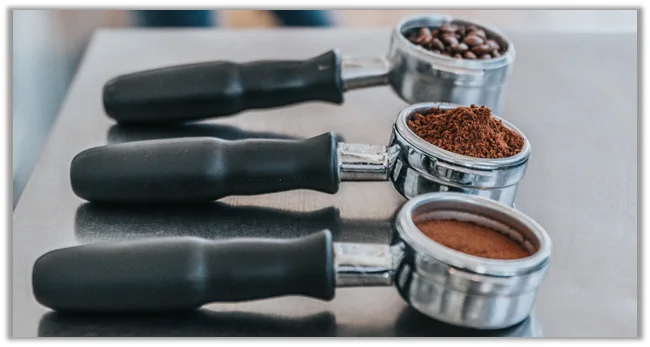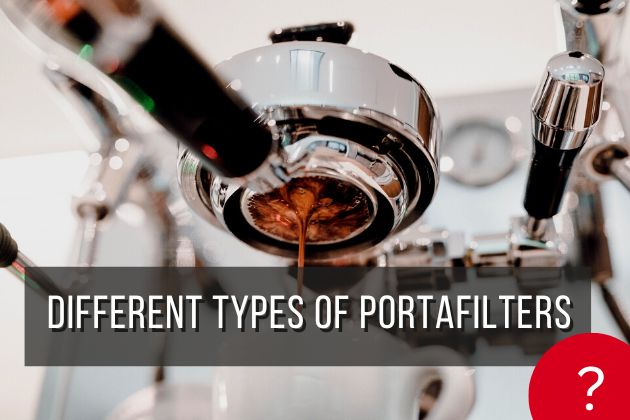Last Updated on July 2, 2023 by Timothy Byron Smith
Portafilters are an essential component of espresso machines, responsible for holding and extracting coffee grounds. Understanding the different types of portafilters can greatly enhance your espresso-making experience.
In this article, we will explore the various types of portafilters available, including their diameters, basket sizes, pressurized vs non-pressurized options, and spouted vs naked designs.
What is a Portafilter?
If you are new to the world of espresso, coffee beans, and espresso machines you must be wondering what even a portafilter is. What does it do? And how do you use it? Your confusions are valid and about to go away.

The portafilter is a metallic filter that holds ground coffee in the espresso machine. It is specially designed to hold finely ground coffee beans and remain sturdy under highly pressurized water. Bad portafilters can leak or spill coffee in your cup, which is why you need quality portafilters.
There isn’t much manual labor involved with the portafilter. All you have to do is fill it with your ground coffee, tamp (apply pressure on the ground coffee using a tamp to even it out), and dust off any residue. Next, you attach it to the espresso machine, it goes right in the middle and locks it in place. That’s it!
Things To Look for In A Portafilter
The first step in choosing a portafilter that extracts espresso phenomenally involves choosing your portafilter basket.

1. Portafilter Diameters
One of the first considerations when choosing a portafilter is its diameter. Espresso machine group heads, the part where you attach the portafilter, come in preset sizes according to the manufacturer’s design. The emerging standard for commercial espresso machines is 58mm in diameter, offering a good balance between coffee quantity and extraction quality. However, smaller home machines may have smaller portafilter diameters.
For example, the La Marzocco Strada and Gaggia Classic both feature 58mm portafilters, while the Breville Infuser has a 54mm diameter. On the other hand, the Flair Espresso Maker utilizes a smaller 40mm portafilter.
It’s important to note that the smaller the portafilter, the less flexibility you have in the amount of coffee you can use, potentially limiting your brewing options.
2. Portafilter Basket Sizes
The size of the filter basket inside the portafilter is another crucial aspect to consider. Most home machines allow you to change the filter basket, but the options may vary among manufacturers. Here are the common basket sizes:
- Single Shot Baskets: These short baskets typically hold around 8-10 grams of coffee and have a smaller set of holes at the bottom. The reduced flow speed helps extract flavors more intensely for a single shot of espresso.
- Double Shot Baskets: The standard for commercial and prosumer machines, double shot baskets can hold between 16-22 grams of ground coffee. They offer a balanced ratio for a traditional double shot of espresso.
- Triple Shot Baskets: For those seeking an extra kick of caffeine, triple shot baskets can hold 30-35 grams of coffee. These baskets are less common but cater to individuals who prefer larger espresso servings.
It’s worth noting that cheaper machines may claim to have double shot baskets but only hold around 10 grams due to their smaller portafilter diameters. For a standard 1:2 shot (1g of coffee to 2g of water), it’s recommended to use a true double shot basket, resulting in a shot volume of around 32-40g.
Pressurized vs Non-Pressurized Portafilters
The next consideration is whether to opt for a pressurized or non-pressurized portafilter. Most portafilters are non-pressurized, allowing the espresso machine to generate the necessary pressure and trap it in the portafilter by tamping the coffee.
However, pressurized portafilters are common in low-level espresso machines and super automatics, catering to beginners and those seeking convenience.
Pressurized portafilters have fewer holes, creating more pressure buildup within the portafilter. While they simplify the brewing process for newcomers, they offer less control over the shot. This limitation can restrict the skill and precision of espresso-making, making them less desirable for those aiming for the highest quality brew.
On the other hand, non-pressurized portafilters provide more control and allow baristas to fine-tune the extraction. With these portafilters, the taste is richer and more noticeable, making them suitable for espresso shots and americano preparations.
Achieving the desired results with non-pressurized portafilters may require experimentation and adjustment of factors such as coffee dose, grind size, and tamping pressure.
Spouted vs Naked Portafilters
The final consideration is whether to go for a traditional spouted portafilter or embrace the trend of naked (bottomless) portafilters. Spouted portafilters come with one or two spouts, allowing the espresso to flow neatly into the cups below.
They are convenient for double shots, enabling the espresso to be evenly divided between two cups. However, single-spouted portafilters may not offer the advantage of splitting shots and are generally less recommended.
Naked portafilters, also known as bottomless portafilters, are gaining popularity in the specialty coffee world. As the name suggests, these portafilters lack spouts, exposing the filter basket completely. This design offers several advantages:
- Easy Detection of Tamping Errors: With a naked portafilter, any unevenness in tamping becomes immediately visible during the extraction process. This allows baristas to refine their tamping technique and achieve more consistent results.
- Improved Consistency: The absence of spouts ensures that the coffee flows evenly from the entire surface of the filter basket. This promotes a more uniform extraction, resulting in a balanced and flavorful shot of espresso.
- More Crema Formation: Naked portafilters facilitate the formation of a thick and creamy layer of crema. The unrestricted flow of espresso promotes better emulsification of oils, enhancing the visual appeal and taste of the espresso.
- Easier Cleaning: Without spouts, cleaning a naked portafilter becomes a breeze. There are no nooks or crannies for coffee residue to hide, simplifying the maintenance process.
For these reasons, naked portafilters are favored by many specialty coffee enthusiasts for their practicality, insightfulness, and visual appeal.
Where to Buy a Portafilter?
Most espresso machines come equipped with their own portafilters. These portafilters are suited to the espresso machine as designed by the manufacturer and also fit the group head perfectly. However, you can easily buy portafilters online or from the same place you got your espresso machine.
Many online platforms such as Amazon have a large variety of portafilters to choose from. In addition to that, you can get them from any kitchen appliance store that keeps espresso machines as well!
Just remember to check the portafilter size and the group head size of your machine before purchasing. Make sure you are getting the right portafilter according to your level of expertise and your preference for portafilter baskets.
Frequently Asked Questions
1. Do all portafilters fit all machines?
Every espresso machine has a predetermined group head size as designed by the manufacturer. Only a specific and precisely sized portafilter will fit that group head. Not all portafilters will fit all machines. However, there is a common size of 58mm used for portafilters.
2. What are portafilters made of?
Commercial portafilters typically are made using stainless steel, durable chrome, and brass material. On the contrary, pressurized portafilters tend to be manufactured using plastic or aluminum.
Summing Up
Choosing the right portafilter for your espresso machine is crucial for achieving the best results. Understanding the different types of portafilters, including their diameters, basket sizes, pressurized vs non-pressurized options, and spouted vs naked designs, can help you make an informed decision. Consider your specific needs, preferences, and level of expertise to select the portafilter that suits you best.
By experimenting with different portafilters, you can refine your espresso-making skills and unlock the full potential of your coffee beans.
Whether you prefer a precise and controlled extraction or appreciate the simplicity and convenience of pressurized options, the right portafilter can elevate your coffee experience.

